Peter MALONE
Saturday, 18 September 2021 19:47
How I Live Now
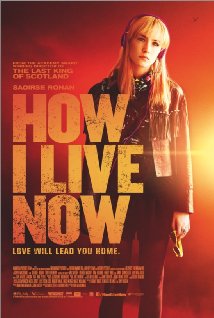
HOW I LIVE NOW
UK, 2013, 101 minutes, Colour.
Saoirse Ronan, George Mackay, Tom Holland, Harper Bird, Anna Chancellor.
Directed by Kevin Macdonald.
How I Live Now is based on a novel by Meg Rosoff. It is a story about teenagers and is geared to the teenage, young adult niche audience. It is written in this style, the characterisations are designed to get young audiences to identify with the characters and their situations, and it is the same with the language.
The film was directed by Kevin McDonald?, an Oscar-winning director of documentaries, including Touch the Void, Enemies. He also directed a few feature films, most notably, The Last King of Scotland for which Forrest Whitaker won an Academy Award.
For those not in the know before they begin to watch the film, there will be something of a surprise in the portrait of the girl who arrives by plane from the United States to stay with her cousins for the summer. We hear the voices in her head during the credits. She is quite a controller, also obsessive, listening to music and surly with people, her clothes with a touch of the Goth, in need of mending, someone with a haughty manner and very little consideration of others. She finds her cousins off-putting as well. Their house could do with some cleaning. There are three children plus the young lad, George, from next door who seems part of the family, the enigmatic Eddie (George Mackay), 16 years old, Isaac (Tom Holland), 14, who was at the airport and drove an old truck home, and the younger girl, Piper (Harper Bird). The visiting cousin is called Elizabeth but she resents this name and wants everybody to call her daisy. She is played by Saoirse Ronan who has proven herself one of the best young actresses (Atonement, The Way Back, The Lovely Bones, The Host).
Audiences will presume that this is a story of someone who feels alien and gradually becomes part of the family and the countryside. Not quite. Or, rather, not at all.
There have been armed soldiers at the airport. We see trucks and soldiers driving through the city and the countryside. It soon appears that there are possibilities of war, the mother of the children being involved in peace activities, going to Geneva for discussions.
Then there is the huge explosion, nuclear, with the destruction of tens of thousands of people in London. War situations then prevail, lack of power, difficulties with food, terrorists (never identified) who have poison the water systems. The children are taken by the army and sent to different sites where they help collect food and try to survive. But, the plan is to escape.
Much of the film is the journey for Daisy and Piper, making their way through the woods, sometimes hiding, trying to survive, a long walk to return home. There are some frightening experiences for them along the way, a crashed plane, men terrorising some women, their being accosted by two men in the woods, finding a container-centre with the bodies of dead boys and young men, preyed on by scavengers.
But, the physical journey is also a psychological and moral journey for Daisy, coming out of herself and her self-centredness, concerned for Piper though irritated by her, letting go of a lot of the controls that she has clung to, listening to the voices in her head very differently.
Some audiences may be reminded of the Australian film, Tomorrow When the War Began, teenagers in a war situation finding ways to survive. But, this is a more character-focused film.
1. From novel to film? For a younger audience? The writing and its style, characterisations, focus of themes for late teens and young adults?
2. A British story, the experience of war, no such war in Britain but similar war and occupations in other parts of the world, for example the Balkans?
3. The British countryside, the woods, the farms, the houses, the roads, the musical school, the range of popular songs and lyrics?
4. The title, Daisy explaining it at the end? What she went through to live in the present, post-war?
5. The voices over the credits, giving a tone, inside Daisy’s mind, explaining her behaviour? Her wanting control? Obsessive, washing her hands? Disdaining bugs? Not wanting to swim because of what was in the river? Eating habits?
6. The introduction, the plane windows, landing in England, listening to music, silent, at passport control, seeing Isaac, her not wanting to be called Elizabeth but Daisy? Her reaction to England?
7. Her appearance, her clothes, needing mending, the Goth touches? Her manner, lacking personal skills? Going to the parking area, reaction to Isaac and
his humour, carrying her own bag, the truck, his driving? The house, the dogs attacking her, inside the house, dirty, the kitchen sink, room? Abrupt and her going to sleep, her disdain for her father?
8. Isaac, bright, 14-year-old, his jokes, going fishing, swimming?
9. Eddie, the older brother, silent, looking at Daisy and her reaction? Her being intrigued? His seeming to have telepathy skills? Helping Daisy, the cows and the fence, pulling her into the river? The kiss? Love, sexual relationship?
10. Piper, her age, bright young girl, interest in things, trying to bond with Daisy?
11. The aunt, her work, her office, phone calls, the computer and the statistics, deaths from war? Going to Geneva, peace talks? The sympathetic talk with Daisy, explaining about her mother being at the house?
12. The visuals of the troops, at the airport, in the streets, trucks going past, an atmosphere of war? Information about deaths? The possibility of world War three? The aunt and her reassurance? The terrorists, being anonymous for the audience?
13. The shock of the bomb, at the river peacefully? The TV news and information? The recording on radio to stay indoors? The loss of electricity?
14. The suddenness of the attack on the house, the brutality, taking the girls separately, Eddie and his advice to return home? The glimpses out of the truck, some devastation on the streets and roads, the countryside? Going to the new home, Mrs McAvoy?, her husband and his supervising the work? The water poisoned? The meals, Daisy urging Piper to eat? sorting the vegetables, the work? The checkpoint, the terrorist occupation, the desparate leaving and the difficulties with the truck? George, find him, the boy next door, his friendship with the family, part of them? The effect of the internment? Getting out of the truck, defying, his being shot?
15. The plan to escape, stocking up, leaving in the confusion, days wandering through the woods, seeing the site of the flight crash, Piper and the chocolates? Not bringing the water pills? Losing the compass? Piper and her feet? Daisy pressing on, dreams about Eddie, continued hopes, her anger with Piper?
16. The gradual transformation in Daisy, the effect of the attack, the internment, the escape, going through the woods, developing a sense of responsibility, change her personality and manner?
17. The overtones of telepathy, Daisy and her sense of Eddie, Eddie and his gifts? Eddie and his sucking the blood from Daisy’s wound, her returning this at the end? Eddie and his comment on Daisy’s voices? Going to Gateshead, the scavengers, Daisy going in, search for Eddie and Isaac, discovering Isaac’s body? Taking his glasses, burying them?
18. Seeing the women being attacked in the woods, the woman victim, giving the gun to Daisy? The two men and their accosting Piper, Daisy and her shooting the men? The effect on other?
19. Arriving home, the ruins, the baked beans, the dog surviving, the howling, finding Eddie, his condition?
20. Helping Eddie, allowing for a gradual recovery, his working in the garden, not speaking, bleeding, Daisy sucking the blood? The final kiss?
21. Peace restored, electricity coming on, the packages being delivered?
22. The story of Daisy and her being transformed by crisis, war, ready for peace?
Published in Movie Reviews
Published in
Movie Reviews
Tagged under
Saturday, 18 September 2021 19:47
Si Parla Italiano: Lygon Street
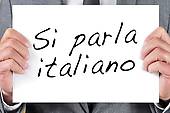
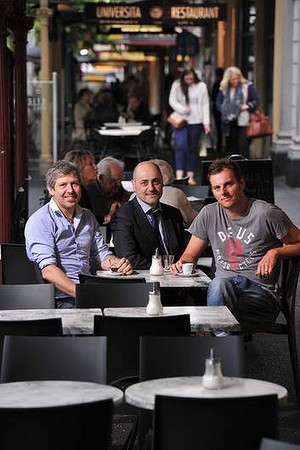
SI PARLA ITALIANO: LYGON STREET
Australia, 2013, 90 minutes, Colour.
Narrated by Anthony La Paglia.
Directed by Directed by
It is not often that a reviewer watches a film in the place where it was made and is in the title. The Nova cinemas in Lygon street, Carlton, in Melbourne, are not featured at the end of the film but they should be. They draw crowds to Lygon Street to the screenings in their 15 cinema site – where we watched this film in Cinema 8.
While this is very much a Melbourne film, it is interesting in itself as an Australian film, a film about post-World War II migration, especially the Italians (one in six of the migrants in those years). It is interesting because of the issues of migration, the reaction to migrants, issues of language, different culture – and, especially, of food and coffee.
Si Parla Italiano is also highly entertaining. There are quite a few talking heads but, especially, a group of older men sitting around reminiscing both in Italian and in English about what has happened in Lygon Street over a period of 60 years and more. There are also some other speakers, all very articulate, the Australian-born wife of a restaurant owner who brings some down-to-earth reflections on what she has seen in the street during the decades. There are also some guest speakers like Sir James Gobbo, former Governor of Victoria as well as Ralph Bernardi, the Lord Mayor of Melbourne, 1979-1980. There is also a guest appearance of Joe Dolce reminiscing about his hit song in 1980, with some visuals of him singing the song, Shaddap Your Face.
Early in the film, there are scenes of the migrants arriving by ship as well is their being put in a camp in the 1950s outside Wodonga where they were isolated from the community, not having an opportunity to get jobs, although some ran away. The main crisis was about food, a Russian cook and his menus and a revolt on the part of the Italians who succeeded in the in their case for being allowed to cook for themselves.
Cooking was one of the key themes for the growth of Lygon Street but, not before the development of different tastes in coffee and the bringing in of espresso machines, the first time in Australia, with some humorous stories about the installation, some touches of rivalry as to who was first, some words from the man whose father established a business bringing in the machines commercially even though some of the Italians did not know how to work them. And there are some stories about the origins of cooking Italian food, setting up Italian restaurants for Italians – and having to call Italy to get details of some of the recipes.
So, by the 1960s and into the 1970s, Lygon Street became a centre for Italians in Melbourne, the opportunity to come and drink coffee, to have an Italian meal, to talk. This had a carry-on effect for friends of the Italians, the Australians coming to frequent Lygon Street and experience Italian food and culture.
There are lots of memories and anecdotes about life in Carlton in those days and the developments which came when Italy won the World Cup in 1982 and thousands descended on Lygon Street to savour the victory. There are pictures of the celebration for the victory in the America’s Cup where people suddenly turned up and celebrated, but at the end of the day the police had to be called in because of drinking and violence, upsetting for the residents of Lygon Street. Further disruption came with young people bringing their cars and using Lygon street as a drag strip. One of the consequences of this was the widening of the foot paths and putting the block down the centre of the street.
Any gangsters? There were some celebrated families but the men around the table continue to say there is no such thing as the Mafia. One of the speakers is the celebrated contemporary Melbourne identity, Mike Gatto, about whom many things are said and surmised. But there were shootings, there were deaths and towards the end of the 1990s, there was concern about Lygon Street. The residents also have many comments about the television series Underbelly (and a number of sequences are incorporated into the film, especially some with that top Italian actor from Melbourne, Vince Colosimo). Many of them agree that Underbelly was an interesting show but they are at pains to indicate how it really didn’t incorporate a lot of the facts and was not realistic.
It is suggested that curiosity about the gangsters, about Underbelly, brought a number of people back to Lygon Street to ask about what it was really like. And so, in the first decade of the 21st-century, people have flocked back to Lygon Street, enjoying the restaurants and the coffee, enjoying the wide foot paths and the possibility for having meals out in the air and sunshine (more in Melbourne than is thought of by those from other states). It is also pointed out that with difficulties in the economies of Europe, and in Italy, a number of young Italians have migrated and a new generation is working in the restaurants of Lygon Street.
Si Parla Italiano, narrated by Anthony La Paglia, offers a fascinating overview of a section of Australian society for more than half a century. It can take its place with other overviews of different aspects of Australian society and culture. While Brunswick Street, Fitzroy, and Acland Street, St Kilda, have acquired a strong reputation for eating and socialising, judging by the crowds outside the Nova, Lygon Street is still very, very popular.
Published in Movie Reviews
Published in
Movie Reviews
Tagged under
Saturday, 18 September 2021 19:47
Mood Indigo
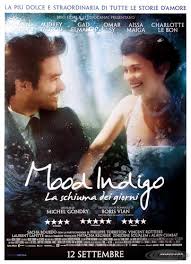
MOOD INDIGO
France, 2013, 125 minutes, Colour.
Romain Duris, Audrey Tautou, Omar Sy, Gad Elamaleh, Aissa Maga.
Directed by Michel Gondry.
Mood Indigo is certainly an arresting title for a film. Those who go to the film out of curiosity about the title will either be enthralled and captivated by its imagination or simply bewildered by the story, the behaviour for the characters, and the steady downward spiral to a mood that is even darker than indigo.
The film is based on a novel by Boris Vian has an amusing quote from him at the opening about the film being true because he made it up from beginning to end. The original title of his novel is L’ecume des Jours. Ecume means froth, but the froth of these days is light while the sadness is deeper.
However, the film is very much the work of writer-director, Michel Gondry. A Frenchman, he is best remembered worldwide for his imaginative film, The Eternal Sunshine of the Spotless Mind, with Jim Carrey and Kate Winslet. This film played with ideas of identity, loss of identity, creation of a new identity, the role of memory. While Mood Indigo does not explore these themes so explicitly, they are there in the background of an unusual story. It might be noted that Gondry also directed Human Nature, The Science of Sleep, Be Kind Rewind.
Audiences know right from the beginning that this is going to be unusual and possibly exotic. The hero, Colin, Romain Duris, a popular star of many French films, is something of an inventor. His house is full of all kinds of mechanical wonders, some very helpful for maintenance, some for cooking, others toy-like inventions. He is assisted by his cook, Omar Sy, the assistant in The Intouchables. Colin would like to be something of a man about town, but is rather a loner and awkward in his manner. His cook, Nicolas, originally from Africa, is a model of urbane manners and hierarchical respect. He also has a talent for modern dancing! So far, so amusing and intelligible. With, of course, the touch of the oddball.
At a social, Colin, on the lookout for feminine company, encounters Chloe (Audrey Tautou as an older Amelie-type), sweet but a touch awkward, but Colin and Chloe fall in love. This brings in Duke Ellington’s music as a theme, with Chloe and other songs. The love story is accompanied by humorous scenes, comic scenes, slapstick scenes, and the intervention of the inventions.
Also at hand is Colin’s friend Chick (Gad Elmaleh) comes to visit, enjoying meals from Nicholas, and play Colin invention, the cocktail piano. Which produces different kinds of drinks according to the chords one plays. Chick is also in love with Nicolas’ niece, Alice.
While the film is often in bright colour, the colour begins to fade somewhat as the film goes on. This is especially true when Chloe is diagnosed with a severe illness, and lily growing in her lung, which needs myriad flowers around her in order to strike the power of the lily. This has a terrible effect on Colin and his mood, desperately in love with Chloe, but spending all his money on doctors and medicines. And he has to find jobs to continue to support her, some really odd jobs, like lying on a mound of earth to give warmth for the growth of a range of bullets for rifles.
Gondry, though he has worked in Hollywood, obviously does not believe in Hollywood endings and the film loses most of its visual colour, moves into the darkness of black and white, and some final symbolic but bewildering images.
(Not all the film reviewers at the preview stayed the length of the film, either becoming bored or exasperated. This is certainly a possibility for many viewers who may be taken aback by the style and story and refuse to be tantalised by its clues. But for those caught up by Vian’s and Gondry’s imagination, they probably might decide to see it again and to put it all together.)
1. Reality and fantasy, the impact of the film, audience interest, enjoyment, imagination, challenge, irritation?
2. Reality and unreality? The surreal style? Allegory, the title of the novel? The title of the film?
3. The animation, cartoon style?
4. Vian and his story, the time of writing, adaptation to the present, the caption that it was true – with ironic comment? Truth versus reality? The importance of Duke Ellington and the musical score?
5. The writing of the book, the computers, moving onto the next, Colin and his typing, failing? The whole book being created – and failing?
6. Colin, in himself, at home, alone, the bath and the hole, gadgets and inventions, the presence of the mouse? Cooking, the television and help, the meals, the piano cocktail? Chick as his friend, the visits?
7. Nicholas, in himself, cooking, eels, complex, moving, the trash, the cake? Calling Colin: Sir, his formalities? Alice, Nicholas and the social, the dance rehearsal, helping, staying, concerned about Chloe, her age? Sympathetic?
8. Chick, author, buying things, drinking the perfume, playing the pianococktail? Alice, love, together, separated, preoccupation, the mannequin, author, shooting, fire?
9. Alice, the niece, Chick, social, Chloe, marriage, the help, concern, especially with the fire?
10. Chloe, Duke Ellington, television, the disks, awkward but nice, with Colin, his embarrassment, the dance, in love, together, the building site, the swan, falling, the proposal, the wedding, in the preparation, running, the race and winning, the church, the ceremony? Nicholas and the ring?
11. The change to ordinary life, and niceness?
12. The change in tone, the fading, black and white, Indigo?
13. Colin, the doctor, the diagnosis, the lily, buying the flowers, the treatment, the difficulties?
14. The Oracle, going to the mountains, getting the job? Chloe, the train, Nicholas and his promise? Getting better in the mountains? Losing his lung, the decline, in the flowers, death?
15. Colin, his money, the payment, the invoice, the job interview, the mockery and laughter, at home? Nicholas, his age, costing?
16. The job, warming the ammunition, naked, failure, the bad shots?
17. Colin, shooting the flowers?
18. The funeral, the pauper and the church? The role of the bridges, reappearing?
19. Throwing the coffin, the hearse, the bridge, the grave, the ending?
20. The experience of the film, from joy and laughter to a grim feeling? And the end underwater?
Published in Movie Reviews
Published in
Movie Reviews
Tagged under
Saturday, 18 September 2021 19:47
Mary Meets Mohammad
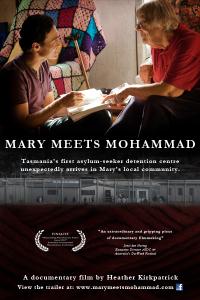
MARY MEETS MOHAMMAD
Australia, 2013, 83 minutes, Cover.Colour.
Directed by Heather Kirkpatrick.
There will probably be no surprise to find that when Mary meets Mohammad, there will be a meeting of minds and hearts. However, the surprise was all Mary’s.
With so many headlines highlighting refugees and asylum seekers, many Australians have been stuck with the names as labels, rather than as seeing the refugees as persons. This documentary is a contribution to understanding and appreciation by doing that most ordinary of things, showing people meeting one another, getting to know one another as persons, and breaking through prejudices.
The film begins with the Australian Federal government’s decision to build a detention centre outside Hobart, at Pontville. It shows the various stages of building, as well as local citizens meeting, objecting to the very idea of a detention centre, claims made about the nature of the refugees, especially as potential terrorists because they are Muslim. The nearest neighbours, sheep farmers, are asked about government consultation which was proclaimed as having happened. They are definitely stating that they were not consulted at all. And the farmer has some harsh things to say, not wanting these people bringing their problems to Australia.
Somebody remarks that Australian and American forces have not been able to defeat the Taliban, what are the Hazaras expected to do!
Factual information is given about Australian policy, information about detention, and information about SERCO who manage the centre.
But then the film becomes quite domestic, showing people that most audiences can identify with (especially older people): the Bridgewater knitting Society. The women decide that they will knit beanies for the anticipated refugees. They become enthusiastic, and liaise with the local Anglican priest and Bishop. There are also two young women, volunteers for visiting refugee centres, who are trying to cut through red tape in order to visit some of the internees. They are required to have the exact names of the people they want to visit and are turned back when there are inaccuracies in the names. The Anglican priest promises to use her influence in getting accurate names.
The volunteers are enthusiastic women in their meeting with the knitters and their talk to camera, communicating their feelings about their work, about the detainees, and preparing visits for the Bridgewater Society.
Amongst the knitters is 71-year-old Mary, a widow, living alone, and quite definite in her not wanting Afghan refugees around the place, let alone in her home. However, she is curious about the stories she has heard about detainees and their luxurious lifestyle – the farmer’s wife quoting three course meals, spas… Well, Mary goes, finds that the men are different from what she was expecting. She continues to visit and becomes very friendly with a Hazara Afghan refugee, Mohammad. Because there was no filming for the media inside Pontsville, some of Mohammad’s conversation is presented as text on screen.
Eventually, Mohammad receives a temporary visa and is released into the community. He is invited to a holiday house owned by Joy, the leader of the knitters. Mary happily goes as well. Again, we see ordinary scenes of Mohammad, in the parks and gardens, talking with the two women, reminiscing about his home in Pakistan, where he lived illegally and could not go to school, his wife still there, though his ringing her for cooking hints for the ladies, his period of mental disturbance. He has a prayer mat and prays, with Mary saying that he seems to be more open to other religions than she is. There are meals, going fishing, conversations between friends, with Mohammad seeing Mary as his Australian grandmother.
It might seem that this is what we should expect from a film like this – but, considering some of the statements of the Tasmanians wary of the detention centre as well as apprehensive about the men themselves, the scenes may well come as a surprise to some Australians, as they would have to Mary before she met Mohammad.
There is a warmth about the film as well as strong campaigning on behalf of the detainees, especially the point of the 90 day limit on detention. And a note to say that the visa for Mohammad’s wife to come could take several years – and one wonders why.
This is a film with a definite point of view, but one worth watching and sharing.
Published in Movie Reviews
Published in
Movie Reviews
Tagged under
Saturday, 18 September 2021 19:47
The Women/ 2008
THE WOMEN
US, 2008, 114 minutes, Colour.
Meg Ryan, Annette Bening, Debra Messing, Jada Pinkett Smith, Eva Mendez, Candice Bergen, Debi Mazar, Cloris Leachman, Carrie Fisher, Joanna Gleeson.
Directed by Diane English.
Back in 1939, Clare Booth Luce's acerbic play, The Women, was adapted for the screen with more acerbic lines and tone by Anita Loos (Gentlemen Prefer Blondes). The play and film were meant to be quite stringent satiric barbs at gossiping New York socialites. It had a total female cast, was directed by George Cukor, and its black and white narrative finished with a fashion show in colour. It was remade and updated in the mid-1950s as a musical, The Opposite Sex.
Can a satire of the 1930s be brought successfully into the 21st century? Originally, writer-director, Diane English (who was the creator and writer for ten years of the popular TV show, Murphy Brown) wanted to make it in the 1990s but finance was not forthcoming. With the popularity of such shows as Sex and the City, there seems to be a place for it now. It does cover a great deal of Sex and the City territory but casts its net a little wider and is not so preoccupied with the principle of 'Expensive is best' (well, at times it is!).
While staying with the general thrust of the play and the film, this version is not quite so acerbic, not quite so barbed in its satire. It has a softer approach in general. Many reviewers referred to it as in the 'chick-flick' vein which is not entirely wrong.
On the whole, the film seems to lack a little oomph. This is evident when Candice Bergen turns up (and she was TV's Murphy Brown herself). She is a strong presence and has some telling lines and delivers them with an elan that raises the level of the film's temperature. Not that the performances aren't good and frequently effective. Once again, there is a large female cast. Meg Ryan is the central character, happily married, she thinks. She is a genial socialite who is having problems with her teenage daughter. Candice Bergen plays her mother. Annette Bening does well as the ageing professional women who is not above gossip and is prepared to be disloyal to her best friend for career's sake. Debra Messing has a good role as the pregnant friend, used to noise and mess – and she gives her all to the birth sequence at the end.
There are assorted cameo appearances by Cloris Leachman, Bette Midler, Debi Mazar, Joanna Gleeson and Carrie Fisher.
And the femme fatale (played by Joan Crawford and Joan Collins in the previous versions) is Eva Mendes.
Enjoyable enough, depending on one's interest in gossip, fashion, relationships and quips, but it doesn't quite stay in the memory.
1. Play and film of the 1930s? Updated to the 21st century? Successfully or not?
2. The perspectives on women, in the United States, in Western culture, women’s autonomy, lack of autonomy, treatment of women, women as objects? Love, marriage, affairs? Coping? Children, family, giving birth? Women in the workplace? Transitions from the 20th to the 21st century?
3. The ensemble cast, no men appearing, except the baby boy at the end?
4. The impact of the lack of male presence, noticed or not? Steve and his story, Alan and Edie and fidelity and infidelity, Mary’s father, Sylvia’s boss, reports about them all their phone calls bringing them into the story?
5. New York, Connecticut, world of affluence, glamour, women’s magazines, the world of fashion? A portrait of this kind of women in society, critique? Saks Fifth Avenue? charity dinners?
6. The feminine perspective, the contribution of Clare Booth Luce and Anita Loos in the 1930s? Ahead of their time? The work of Diane English? How successful with this film?
7. Themes of friendship, the single career woman, mothers, working mothers, the Lesbian and her partner? The grandmother generation? The guests at the dinners? Bailey and the world of the writer? Crystal and her work in the store? The manicurist and her gossip? Maggie and her work in the kitchen, Mary’s daughter a a significant female presence, the au pair?
8. The first act: the party and its preparation? The introduction to Sylvie, her work at the magazine, her life and style, gossiping, barbed wit? Getting her nails done, listening to the manicurist, the discovery of the affair? Going to visit Edie, with the kids? Edie and her pregnancy? The large family? Alex, the Lesbian, her model partner and her moods? Mary, at home, busy, in the garden, cooking, the shower and getting ready for the party, her daughter’s request for help with the assignment? The guests, the success of the party, Mary’s achievement?
9. The group and talking about Mary, keeping the affair secret? Mary and her visit to the manicurist, listening to the chatter, discovering the truth, her reaction? Her friends’ reaction to her knowing?
10. The second act: dealing with the affair? Sylvie and her making friends with Mary’s daughter, chats, the phone calls, support? The boss and the pressure on the magazine, the staff meeting, the younger girls with creative ideas, an issue on revenge, Sylvie finally having to propose this to save the magazine? The discussions with Bailey, the issue of betraying Mary, Sylvie’s motivations, the publication of the article? Mary seeing it, her reaction to Sylvie’s betrayal?
11. Edie and the group, going to Saks, confronting Crystal, the bluntness? Her own secret? Revelation in the hospital?
12. Mary’s mother, a character, her marriage, the meeting with Mary, the meal, talking about her past, the affair, her pride, determination, time wasted and not doing what she wanted to do, the bond with her daughter?
13. Mary, the gossip, its effect on her? Separating from Steve, her moods, at home, the reaction of her daughter? Not answering phone calls?
14. Maggie, at work in the kitchen, her blunt talk to Mary? The au pair in the house?
15. Crystal, the audience hearing about her, the gossip, the affair, her motivation? The style and look? At work, the issue of the perfume, the three confronting her at the counter? Her comments, about Stephen, her attitude towards the affair?
16. Act three: the resolution? Mary, the change, becoming independent, going to see her mother when she was having plastic surgery, her mother giving her the finance for designing her clothes? The dress shop, Crystal in the other room, Sylvie urging Mary to confront her, the discussions, the effect on each of the women, Sylvie listening in? Outside, on the steps, the reconciliation with Sylvie? Sylvie giving up her job? Mary’s problems about her daughter and her reliance on Sylvie?
17. Mary, her father, expecting to get the company, her father firing her, becoming creative, preparing for the show, the show itself, the style of the dresses, the catwalk, the audience, those attending, her daughter proud of her, her friends, the Saks buyer?
18. The daughter and her friend, smoking, confiding in Sylvie, going to her father’s place, the discussion with Crystal in the bath?
19. Edie, going to the hospital, giving birth, the three women and their participating, the effect on each of them, the staff? The birth of the boy? Edie talking about forgiveness and her own lapse with Alan?
20. The phone call, Steve, the possibilities for reconciliation and forgiveness?
21. The credits at the end, the various images, the new magazine, the comments of the women?
US, 2008, 114 minutes, Colour.
Meg Ryan, Annette Bening, Debra Messing, Jada Pinkett Smith, Eva Mendez, Candice Bergen, Debi Mazar, Cloris Leachman, Carrie Fisher, Joanna Gleeson.
Directed by Diane English.
Back in 1939, Clare Booth Luce's acerbic play, The Women, was adapted for the screen with more acerbic lines and tone by Anita Loos (Gentlemen Prefer Blondes). The play and film were meant to be quite stringent satiric barbs at gossiping New York socialites. It had a total female cast, was directed by George Cukor, and its black and white narrative finished with a fashion show in colour. It was remade and updated in the mid-1950s as a musical, The Opposite Sex.
Can a satire of the 1930s be brought successfully into the 21st century? Originally, writer-director, Diane English (who was the creator and writer for ten years of the popular TV show, Murphy Brown) wanted to make it in the 1990s but finance was not forthcoming. With the popularity of such shows as Sex and the City, there seems to be a place for it now. It does cover a great deal of Sex and the City territory but casts its net a little wider and is not so preoccupied with the principle of 'Expensive is best' (well, at times it is!).
While staying with the general thrust of the play and the film, this version is not quite so acerbic, not quite so barbed in its satire. It has a softer approach in general. Many reviewers referred to it as in the 'chick-flick' vein which is not entirely wrong.
On the whole, the film seems to lack a little oomph. This is evident when Candice Bergen turns up (and she was TV's Murphy Brown herself). She is a strong presence and has some telling lines and delivers them with an elan that raises the level of the film's temperature. Not that the performances aren't good and frequently effective. Once again, there is a large female cast. Meg Ryan is the central character, happily married, she thinks. She is a genial socialite who is having problems with her teenage daughter. Candice Bergen plays her mother. Annette Bening does well as the ageing professional women who is not above gossip and is prepared to be disloyal to her best friend for career's sake. Debra Messing has a good role as the pregnant friend, used to noise and mess – and she gives her all to the birth sequence at the end.
There are assorted cameo appearances by Cloris Leachman, Bette Midler, Debi Mazar, Joanna Gleeson and Carrie Fisher.
And the femme fatale (played by Joan Crawford and Joan Collins in the previous versions) is Eva Mendes.
Enjoyable enough, depending on one's interest in gossip, fashion, relationships and quips, but it doesn't quite stay in the memory.
1. Play and film of the 1930s? Updated to the 21st century? Successfully or not?
2. The perspectives on women, in the United States, in Western culture, women’s autonomy, lack of autonomy, treatment of women, women as objects? Love, marriage, affairs? Coping? Children, family, giving birth? Women in the workplace? Transitions from the 20th to the 21st century?
3. The ensemble cast, no men appearing, except the baby boy at the end?
4. The impact of the lack of male presence, noticed or not? Steve and his story, Alan and Edie and fidelity and infidelity, Mary’s father, Sylvia’s boss, reports about them all their phone calls bringing them into the story?
5. New York, Connecticut, world of affluence, glamour, women’s magazines, the world of fashion? A portrait of this kind of women in society, critique? Saks Fifth Avenue? charity dinners?
6. The feminine perspective, the contribution of Clare Booth Luce and Anita Loos in the 1930s? Ahead of their time? The work of Diane English? How successful with this film?
7. Themes of friendship, the single career woman, mothers, working mothers, the Lesbian and her partner? The grandmother generation? The guests at the dinners? Bailey and the world of the writer? Crystal and her work in the store? The manicurist and her gossip? Maggie and her work in the kitchen, Mary’s daughter a a significant female presence, the au pair?
8. The first act: the party and its preparation? The introduction to Sylvie, her work at the magazine, her life and style, gossiping, barbed wit? Getting her nails done, listening to the manicurist, the discovery of the affair? Going to visit Edie, with the kids? Edie and her pregnancy? The large family? Alex, the Lesbian, her model partner and her moods? Mary, at home, busy, in the garden, cooking, the shower and getting ready for the party, her daughter’s request for help with the assignment? The guests, the success of the party, Mary’s achievement?
9. The group and talking about Mary, keeping the affair secret? Mary and her visit to the manicurist, listening to the chatter, discovering the truth, her reaction? Her friends’ reaction to her knowing?
10. The second act: dealing with the affair? Sylvie and her making friends with Mary’s daughter, chats, the phone calls, support? The boss and the pressure on the magazine, the staff meeting, the younger girls with creative ideas, an issue on revenge, Sylvie finally having to propose this to save the magazine? The discussions with Bailey, the issue of betraying Mary, Sylvie’s motivations, the publication of the article? Mary seeing it, her reaction to Sylvie’s betrayal?
11. Edie and the group, going to Saks, confronting Crystal, the bluntness? Her own secret? Revelation in the hospital?
12. Mary’s mother, a character, her marriage, the meeting with Mary, the meal, talking about her past, the affair, her pride, determination, time wasted and not doing what she wanted to do, the bond with her daughter?
13. Mary, the gossip, its effect on her? Separating from Steve, her moods, at home, the reaction of her daughter? Not answering phone calls?
14. Maggie, at work in the kitchen, her blunt talk to Mary? The au pair in the house?
15. Crystal, the audience hearing about her, the gossip, the affair, her motivation? The style and look? At work, the issue of the perfume, the three confronting her at the counter? Her comments, about Stephen, her attitude towards the affair?
16. Act three: the resolution? Mary, the change, becoming independent, going to see her mother when she was having plastic surgery, her mother giving her the finance for designing her clothes? The dress shop, Crystal in the other room, Sylvie urging Mary to confront her, the discussions, the effect on each of the women, Sylvie listening in? Outside, on the steps, the reconciliation with Sylvie? Sylvie giving up her job? Mary’s problems about her daughter and her reliance on Sylvie?
17. Mary, her father, expecting to get the company, her father firing her, becoming creative, preparing for the show, the show itself, the style of the dresses, the catwalk, the audience, those attending, her daughter proud of her, her friends, the Saks buyer?
18. The daughter and her friend, smoking, confiding in Sylvie, going to her father’s place, the discussion with Crystal in the bath?
19. Edie, going to the hospital, giving birth, the three women and their participating, the effect on each of them, the staff? The birth of the boy? Edie talking about forgiveness and her own lapse with Alan?
20. The phone call, Steve, the possibilities for reconciliation and forgiveness?
21. The credits at the end, the various images, the new magazine, the comments of the women?
Published in Movie Reviews
Published in
Movie Reviews
Tagged under
Saturday, 18 September 2021 19:47
Magic Magic
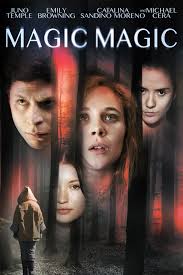
MAGIC, MAGIC
Chile, 2012, 80 minutes, Colour.
Juno Temple, Augustin Silva, Emily Browning, Michael Cera.
Directed by Sebastien Silva.
Magic, Magic is a film by Chilean director Sebastien Silva who directed the atmospheric 2009 film, The Maid. Atmosphere is an important word for this director, who concentrates very much on atmosphere surrounding his characters.
In this case, the characters are generally a group of young adults, with some older local Chileans added in. The central character is Alicia, played by the British Juno Temple, a young woman who has not travelled outside the United States but has come with her cousin, Sarah (Emily Browning) and her Chilean friends. They are on holidays in the countryside, travelling to an island off the Chilean coast.
All seems normal enough except that Alicia is a nervous traveller, compounded by the fact that Sarah is called back to the United States to sit for an exam. This disconcerts Alicia but she is persuaded not to return home and to travel with the group to the island.
Augustin (Augustin Silva) is Sarah’s boyfriend and is considerate towards Alicia. His older sister (Catalina Sandino Moreno) is rather aloof and unwelcoming. The other character is a friend of Augustin, an American from a diplomatic or family, Brink (Michael Cera). He is a rather obnoxious character, pranks and jokes, with a sadistic touch.
However, the point of the film is Alicia’s mental deterioration on the island. Away from home and what she is used to, she feels alienated from the group, welcoming Sarah back from the United States, but unable to sleep, on tenterhooks, wandering away from the group. One major episode, long in this short-running film, is the challenge to Alicia to jump from a cliff, continually urged by the others, focusing on her delay and fear. Later, when things come to a head, the night, the darkness, strange experiences with animals, local traditional rituals, Alicia goes to the cliff again to jump.
The film stops rather than bringing the drama to a conclusion. It is over to the audience to speculate on Alicia’s future, what will happen to her in the short term with the others on the island, what will happen to her long-term.
Since the characters are not particularly engaging, some audiences will find it difficult to identify with them or warm to them. Rather, it is a film of atmosphere and observing Alicia and her mental collapse.
1. The divided response to this film, some seeing it as a masterpiece, other seeing it as weird and boring?
2. A Chilean film, the Chilean director and writers? In English and Spanish? The American cast? The Chilean caste? A satisfying blend of influence from different cultures?
3. The title, Alicia’s experience, nightmares, rituals, paranoia?
4. The Chilean setting, the opening with the landscapes and the sea? The island? The opening in the city, travelling through the Chilean countryside, the boat, the island?
5. Alicia, her relationship with Sarah, not travelling outside the United States, coming to Chile, her apprehension? The gradual revelation of her nerves and mental state? Sarah being called back to America for an exam? The effect of her absence? Alicia wanting to go home? Being persuaded to continue? The trip, the car, the anxieties, the conversations? The boat to the island?
6. Alicia, her room, her relationship with the other characters, brink and his jokes and sadistic touches? Augustin and his welcome? Barbara, her aloofness and criticism?
7. The holiday, the effect on Alicia, by herself, with the group, meeting Bernardo, meeting Melda? Their help, especially for Alicia’s collapse? The local culture?
8. Alicia, not being able to sleep, the food, and nightmares, the animals, putting the dog out on the road, the animals on the island?
9. Sarah, agreeable, her return? A salutary effect on Alicia?
10. The character of Brink, the diplomatic family, studying in South America, American, his practical jokes, offhand remarks, Alicia and the difficulties in dealing with him? The character of Barbara, older, working, sympathetic and unsympathetic? Augustin and his being more sympathetic?
11. Alicia, withdrawing into herself, imaginings, reactions to the others, going off by herself? The importance of the sequence on the cliff? So much time given to it, the others urging her to jump, accounting, her remaining at the top? The effect on her, embarrassment, seeming weakness?
12. Returning to the cliff, her jump, the reaction of the others, trying to get her, bring her out of the water? The attempts to revive Alicia?
13. The film stopping, leaving it to the audience to speculate about what would happen?
Published in Movie Reviews
Published in
Movie Reviews
Tagged under
Saturday, 18 September 2021 19:47
Million Dollar Rip- Off, The
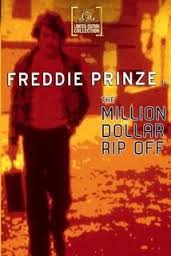
THE MILLION DOLLAR RIP-OFF
US, 1976, 73 minutes, Colour.
Freddie Prinze, Alan Garfield, Christine Belford, Joanna Kearns.
Directed by Alexander Singer.
The Million- Dollar Rip- Off is a conventional telemovie, typical of entertainments made for television in the mid-1970s. It is a heist caper, an electronics genius and a gang of women friends who decide to pull off a big robbery. Alan Garfield plays a police officer who is suspicious of them. There are a few twists along the way. One of the main reasons for looking at the film is that it features a rare dramatic role for the comedian Freddie Prinze.
1. How entertaining a caper film?
2. The organisation of criminals, the master minding of the plot, the rehearsals, the gimmicks? The presentation of security and police? Electronics and robberies? How different with disguises, electronic information, the women?
3. City locations, music, trains, pickups, the police? authentic atmosphere for this kind of robbery?
4. The significance and tone of the title? Muff as a credible character, his work, electronic skills, prison? The planning of the robbery? The human element and the women's fears, the trail, Lubeck and his taking over the plot? The presentation of the police and their being bugged? The human side of the police? The build-up to the execution of the robbery, details, the humorous aspects, the disguises, the personalities of the women? Rendezvous, moments of tension with the truck, with Fogarty watching? The finale at the airport according to Muff's plans? Finding out the traitor?
6. The character of Muff as a credible criminal, smooth operator?
7. The four women and their roles? The other criminals? The portrayal of the police, Fogarty as sympathetic, harassed, trying to do his job, his assistant, relationship with authorities, his trying to thwart the crimes, exasperation e.g. with the garbage truck? shrewdness at the airport, the robbery? The irony of their money going up in smoke and their not being arrested? How seriously was it meant to be taken? Invitation to audience admiration for the mastermind and the execution of crime? Sheer entertainment?
Published in Movie Reviews
Published in
Movie Reviews
Tagged under
Saturday, 18 September 2021 19:47
Mr Pip
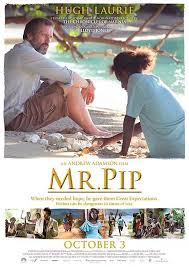
MR PIP
New Zealand, 2012, 116 minutes, Colour.
Hugh Laurie, you can Darville.
Directed by Andrew Adamson.
Mr Pip is a New Zealand production, based on a story by Lloyd Jones, a journalist reflecting on the experiences of Bougainville in 1989, the closure of the copper mine, the financial crisis and the international companies, the rise of rebels and the intervention of the Papua New Guinea military. It has been adapted for the screen by the director, Andrew Adamson, director of the first two Shrek films and the first two Chronicles of Narnia films.
The photography for the film, in Bougainville itself, is very beautiful and offers the audience the flavour of the South Pacific. The audience is immersed in the life of the village, the hardships of the blockade, the closure of the schools. Later in the film the action will move to Mt Isa in Queensland as well as to London.
In fact, the film opens in London where the central character, the 14-year-old girl grown to womanhood, Matilda (ZX) is visiting the Dickens Museum. Audiences will be wondering what the girl is doing in London. The film then moves to flashback and tells the story of the girl and her encounter with an Englishman, Mr Watts (Hugh Laurie making a strong impression).
The core of the film is Mr Watts deciding to start some classes for the children on the island. He is not a teacher but has a profound love of Dickens, especially for Great Expectations. This seems an unlikely book for children on Bougainville. However, he begins to read and the children respond, especially with their imaginations and the development of comprehension. Matilda responds very well to the novel, even to imagining herself in the situations of the novel, with Pip and Magwich in the cemetery, with Pip going to see Miss Haversham, with the grown-up Pip in London… The film is strong in showing the power of the storytelling, the power of the imagination, the possibilities for education with such storytelling. (And a reminder of how the Taliban takes stances against this kind of schooling for girls.)
There is a difficulty with Matilda’s mother, the leader of the church on the island, a Protestant-evangelical church, where she also conducts the choir, carries the Bible, and thinks that there is something too secular about reading Dickens instead of the Bible. When the military arrive, she has taken the book and hidden it in a large mat. There are dire consequences because of this.
While the sequences of Mr Watts working with the children are very congenial, the mood changes considerably with the arrival of the military, the toughness of the commander, the laissez-faire attitudes of his soldiers and their disregard of the locals. The commander makes the mistake of thinking that Mr Pip is a real person and that the village people are hiding him. When he returns second time, his avowed intention is to uncover Mr Pip with grim threats to the villagers. It is at this moment that there is a change of atmosphere with the shock of military brutality, murder and rape (and a reminder that this kind of brutality continues all over the world, in such places as the Congo and Sudan, and in the civil war in Syria).
The experiences have harsh consequences for Matilda. However, she is fortunate in being to go to Australia, to Mount Isa and stay with her father. And, in some act unexpected circumstances, she goes to London for the visit that we saw at the opening of the film. There she meets Mr Watts’s wife (Kerry Fox) and learns a lot about her teacher and why he was in Bougainville, about his Bougainvillean wife, her depression, the pathos of the reasons for it and Mr Watts’ self-sacrifice.
In many ways, the film takes on too many issues, so that during the film the audience have to move dramatically from one to another, sometimes surprisingly, but, by the end, within the two hour running time, the audience does have the opportunity to consider all these issues, whether political and economic, whether educational, whether economic or dealing with refugees and working migrants.
1. A South-Pacific? story, Papua New Guinea, Bougainville, United Kingdom interests, Australian background? A New Zealand film?
2. Audience knowledge of Bougainville, of the difficulties in 1989, the closing of the copper mines, the job losses, migration, the rise of the rebels, the presence of the Papua New Guinea military, terror and brutality, the blockade of Bougainville?
3. The Bougainville context, traditional life, by the 1980s, life in the village, yet modern, the role of the church, of religious practice in faith, men leaving for work in Australia? Development? Halted?
4. The location photography, the village, the houses, the sea, the church, the bush? The musical score?
5. The Australian sequences, Mt Isa, the airport, the school, the homes, the atmosphere of outback Queensland?
6. The comparison with the United Kingdom, Gravesend, London, the streets, houses, Dickens’ Museum?
7. The introduction to Matilda, in London, going to the Dickens house, audience is puzzle as to why she was there?
8. The flashbacks, Matilda, the explanation of her name from the Australian workers, her mother, a leader in the church, seeing her speaking, conducting the choir, carrying the Bible, her religious beliefs? The father gone to Australia, some postcards? Matilda’s age, experience, a clever girl, excelling at school, the encounter with Mr Watts, reading Great Expectations, using her imagination, the story coming alive with her in it, in the local context but with British costumes? Clash with her mother? The Scripture versus Great Expectations?
9. Hugh Laurie as Mr Watts, the gradual revelation of his story, life in England, his marriage to Grace, birth and his wonder, the death of the baby, the depression, the red nose and the Queen of Sheba carriage? The opinion of him on the island? Going to the school, gathering the children, their response? His love for Dickens, Great Expectations? Quoting the initial line, Pip? Talking to the children, influencing them, the personal relationships? Daniel, Christopher and the other boys?
10. Matilda’s mother, the talk, telling the children to read the Bible, her wariness about Dickens? The other mothers and their coming to the readings? Her taking the book, hiding it in the mat, Matilda finding it but leaving it there, the consequences for Mr Watts, and for her own death?
11. The military, the harshness, searching for Mr Pip, the treatment of the people, the demands, not knowing Dickens, Matilda and the search for the book, not finding it, a gathering of all the books and burning them? The burning of the furniture? The later return, the commander, his arrogance, the demands, Watts and the quote, his sudden death, taken, hacked? Daniel and his saying he had witnessed it? The people keeping silent? Matilda’s mother and her assertion that she was a witness? Her being taken, raped, the bargain of her life her daughters, her death?
12. The funerals on the island, Grace’s death, the burial, for Mr Watts, for Matilda’s mother?
13. Mr Watts telling his story, the house in London, love, the birth of the child and his tenderness, the death of the baby and Grace descending into depression, their moving and settling in Bouganville?
14. The scenes of the novel coming alive, Pip his personality, the text, the definition of a gentleman, yet his being a snob, Matilda rebuking him, his late his being late for the meeting with Miss Haversham, the scenes in the cemetery with Magwich? The final rescue, his appearing at the end?
15. The village, the people, the oppression, there being victims? Matilda revisiting the copper quarries with the huge machinery and everything stopped?
16. Matilda, outside the village, seeing the red nose on the branch, going into the water, the rapids, washed away, in the sea, the rescue by the boat?
17. Going to the plane, to Mt Isa, meeting her father again, the room for a little girl, going to school, the introduction by the teacher? The scene in the library, the time-lapse photography of the books and the passing of the years?
18. Finding Matilda, the will, the lawyer, the house in London, going to England, to Gravesend, the modernity, the contrast with Bougainville, meeting Mrs Watts, the discussions, the tour of the house, Mrs Watts and her bitterness, especially about Grace? Matilda saying Mr Watts was always a gentleman? Taking the book? Seen the posters for the theatre on the world, and especially the chariot in the Queen of Sheba?
19. The Dickens Centre, the young man guiding Matilda, the Dickens tableau? The going home, the comments about home and not being ashamed of home? Her teaching the children?
20. The wide scope of the film, the range of characters and issues?
Published in Movie Reviews
Published in
Movie Reviews
Tagged under
Saturday, 18 September 2021 19:47
Slaves of Babylon
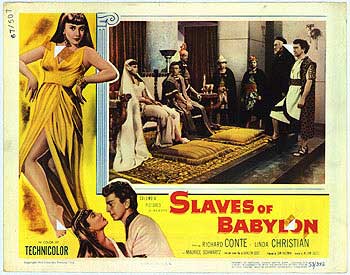
SLAVES OF BABYLON
US, 1953, 82 minutes, Colour.
Richard Conte, Linda Christian, Terrance Kilburn, Michael Schwartz, Michael Ansara.
Directed by William Castle.
Sleeves of Babylon was one of those matinee, short running-time, action adventures that served as supporting features in the early 1950s. It was an early film from William Castle as director, before he moved into the idiosyncratic horror films of the late 1950s, early 1960s, films such as The House on Haunted Hill, The Tingler… each with its own special gimmick to promote the film or to create fear in the prospective audience.
The basic plot for this film comes from the book of Daniel, chapter 6. It also relies very much on the exodus story of Moses, the Genesis story of Joseph and his ruling in Egypt. It shows the Jews in Babylon after the destruction of Jerusalem by Nebuchadnezzar. Nebuchadnezzar is a character here, a friend of the prophet Daniel (Maurice Schwartz), seen as an elderly man. His son, Balthazar, is also a character, itching to take over from his father as ruler of Babylon. When he does so, he is a tyrant.
Richard Conte portrays an Israelite who sacrifices his life and his marriage to go in search of a potential saviour for the people of Israel, to free them from Babylon, to allow them back to their own land. Much of the film shows his journey and his seeking out of Cyrus, the promised one. While Cyrus is a significant figure in the Jewish and Biblical literature, the man who conquered Babylon and allowed the Israelites to go home, much is made of his being a shepherd, echoes of King David, and the mystery of his birth. His adoptive parents saved him from death, the mother having her tongue removed. She proves on her coming to the city, to the King’s daughter, that this is the princess’s child whom she thought was dead.
Child actor, Terry Kilburn (Goodbye Mr chips), is Cyrus. Linda Christian is the femme fatale, who wants to be Queen, tries to make a liaison with Cyrus, falls in love with Richard Conte’s character but is finally made to make a moral choice.
Towards the end of the film, the famous scene from the book of Daniel, the mysterious hand writing on the wall with the warnings to Balthazar, brings a touch of drama.
And, of course, the film ends with Cyrus firmly enthroned in Babylon and the people of Israel making their way back to Jerusalem.
Published in Movie Reviews
Published in
Movie Reviews
Tagged under
Saturday, 18 September 2021 19:47
Saint Takes Over, The
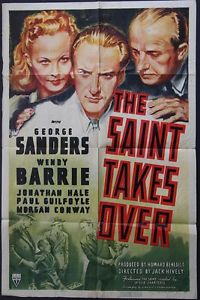
THE SAINT TAKES OVER
US, 1940, 69 minutes, Black and white.
George Sanders, Wendy Barrie, Jonathan Hale.
Directed by Jack Hively.
The Saint Takes Over is the fifth film in the Saint series. A very suave 30ish George Sanders had settled himself into the role – although, in this film, it is something of a surprise to see him involved in fisticuffs.
The series started at the end of the 1930s and continued into the 1940s. The stories are based on novels and short stories by Leslie Charteris.
The plot is fairly conventional, Simon Templar, the Saint, returning to the United States to defend a friend who is accused of a crime of which he is innocent. On the boat, he meets a young woman and is attracted to her.
The plot involves gangsters who are responsible for the death of a young man. The treatment of the gangsters is as might be expected. However, the young woman turns up again in suspicious circumstances. It emerges that she is the sister of the murdered man and is out to get vengeance. This means that she becomes entangled with the Saint, and while achieving her vengeance, suffers the consequences.
The Saint series entertains in a basic kind of way, but is best seen as an example of this kind of second feature from the 1940s.
Published in Movie Reviews
Published in
Movie Reviews
Tagged under